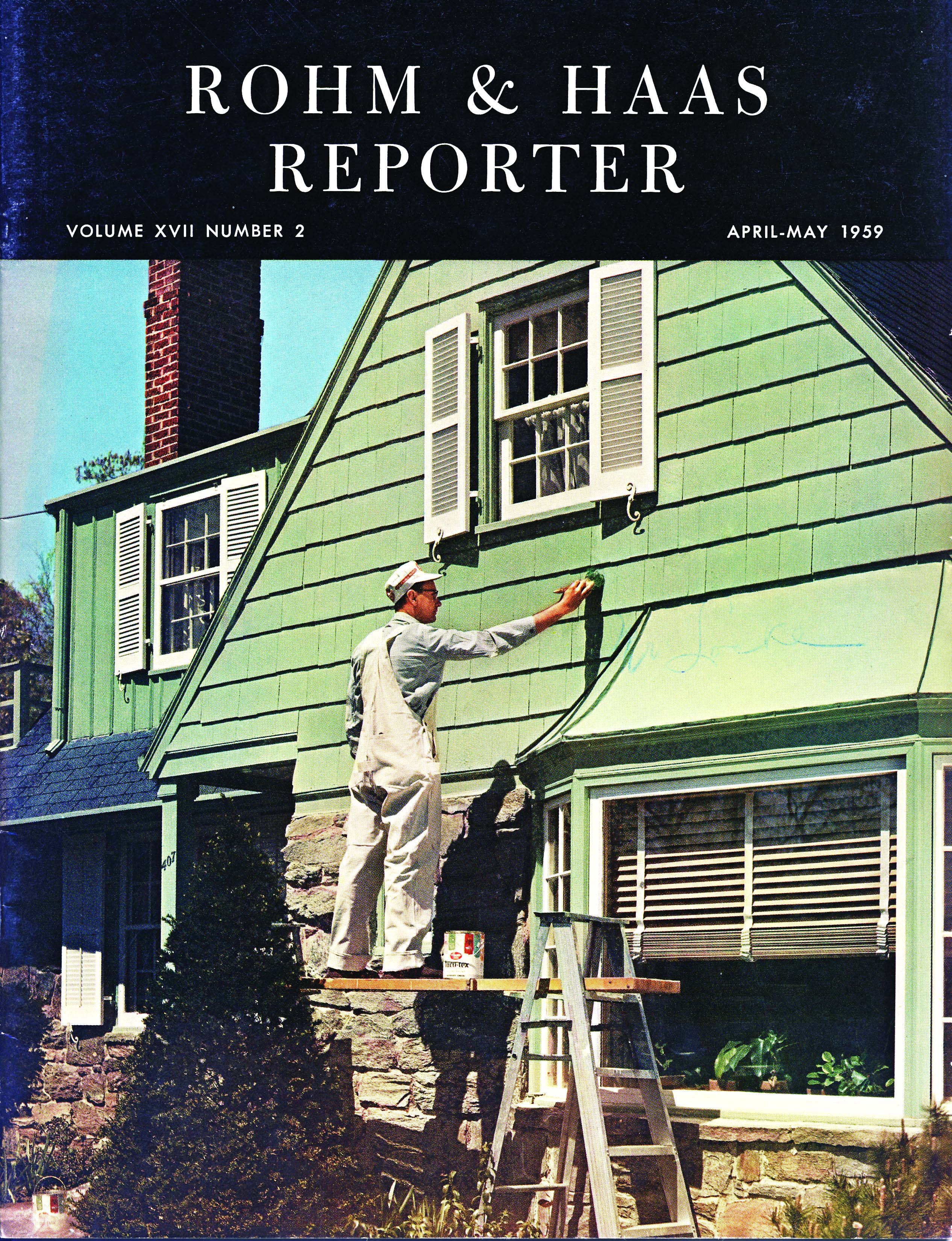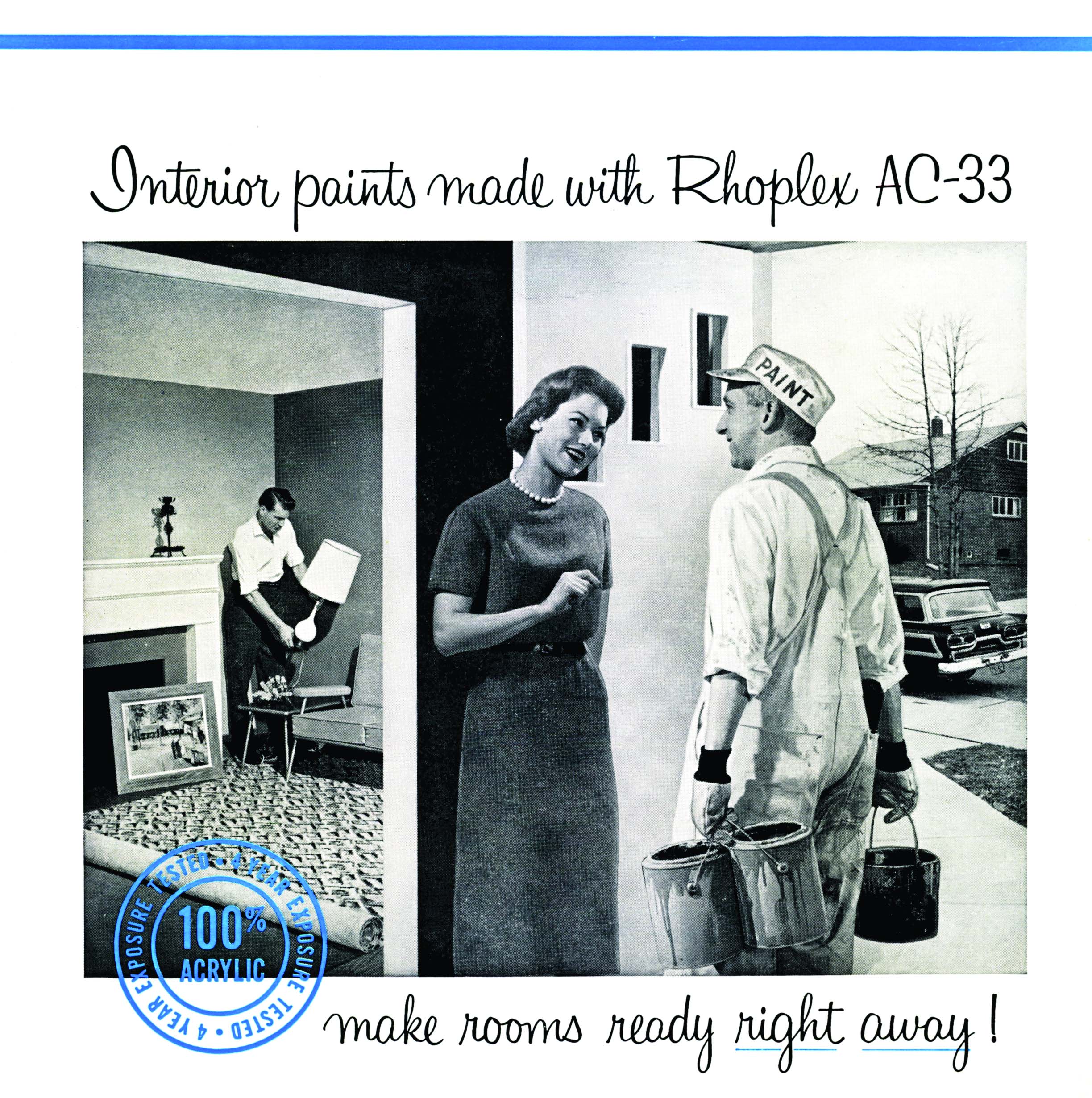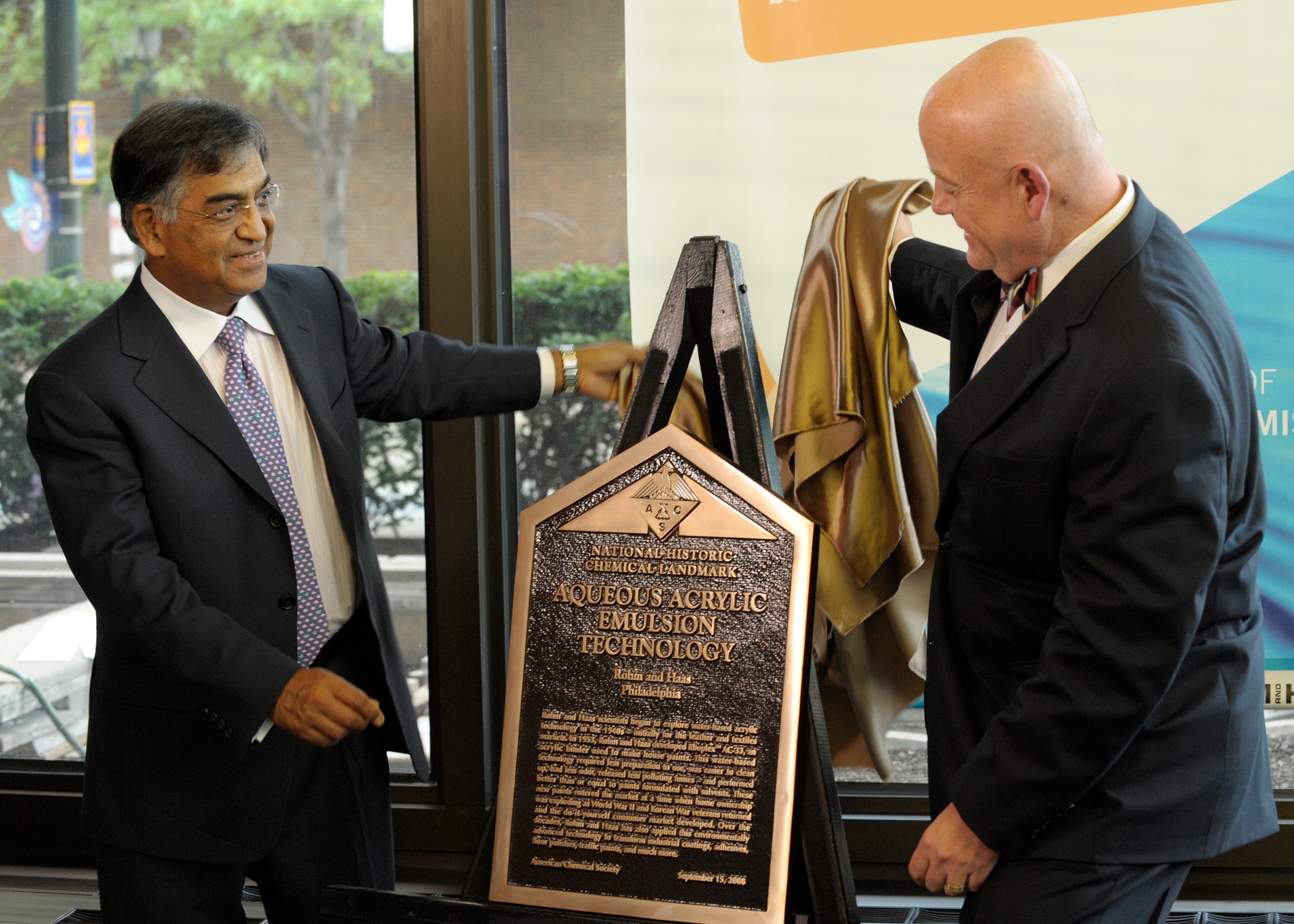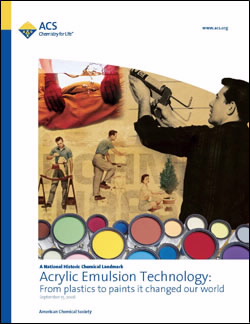Acrylic Emulsion Technology
Dedicated September 15, 2008, at Rohm and Haas (now The Dow Chemical Company) in Philadelphia, Pennsylvania.
Developed by Rohm and Haas in the 1940s, water-based acrylic emulsion technology filled a need for easy-to-use household paints for a growing suburban population in the United States following World War II. This aqueous technology required less preparation to use, was easier to clean up, had less odor, and performed better than or equal to paints made with solvents. It was also a leap forward in acrylic chemistry.
Contents
Setting the Stage for Acrylic Paints
August 14, 1945 was a joyous day. World War II was finally over. In New York City’s Times Square, an exuberant sailor kissing a nurse became the iconic image of the era. Soon, “the boys” would be coming home, gladly discarding howitzers for houses, submarines for suburbia and parachutes for paint brushes.
America was about to change, and Rohm and Haas, a small Pennsylvania-based specialty chemical company, needed to change with it. Plexiglas™, Rohm and Haas’s lightweight, shatterproof acrylic glass substitute used in airplanes and other military vehicles, was the backbone of the company’s war effort.
In the postwar years, manufacturers would use Plexiglas to make illuminated signs, car taillights, skylights and other goods. However, company leaders knew that Plexiglas sales would never again reach World War II levels. In order to grow and thrive as America turned from war to peace, the company needed to find other uses for acrylics.
The ultimate solution—aqueous acrylic emulsion—took years to develop and perfect. But in the coming decades, it would revolutionize our lives.
Acrylic emulsion chemistry would also transform Rohm and Haas from a modest enterprise into a dominant force on the cutting edge of acrylic technology. Getting to that point took audacity, tenacity and a knack for innovative chemistry: three traits that company founders Otto Rohm and Otto Haas had in abundance and instilled in their workforce.
Rohm and Haas: Pals, Partners and Pioneers
Long before he formed a business partnership with his friend Otto Haas in 1907, acrylic chemistry fascinated Otto Rohm. From the earliest days of his research—his 1901 doctoral thesis discussed polymerization products of acrylic acids—Rohm was convinced that acrylic acid derivatives had commercial potential. But developing these applications would take time.
Meanwhile, Rohm, a German chemist, and Haas, a German merchant who immigrated to the United States and established the American offshoot of their company in 1909, were busy cultivating their business in other areas. It wasn’t until after World War I that they were able to concentrate on Rohm’s earlier acrylic polymerization work and develop prototypes of what was to become known as Plexiglas.
One of their biggest challenges was synthesizing acrylic monomers—the single molecule building blocks used to form polymers. Producing these monomers was expensive, time-consuming and generated relatively low yields. These difficulties limited potential markets, especially in areas of coatings and molding powders. Rohm would work on this problem until his death in 1939.
Haas’s quest to develop an efficient and economical synthesis of acrylic monomers began in earnest in 1946 and would take three years. Eventually, company scientists, led by chemist Harry Neher, produced a synthesis based on earlier work by I.G. Farben scientist Walter Reppe. I.G. Farben was a large German chemical company that conducted early acrylic research and had worked with Rohm and Haas on several projects prior to World War II. Reppe’s process used unique starting materials, principally acetylene and nickel carbonyl. After making several important modifications, Neher created a new semi-catalytic process—later known at Rohm and Haas as the F Process—that improved on Reppe’s discovery and made production of vast qualities of cheap acrylate monomers possible.
But what to do with it? At the time, Rohm and Haas’s three largest acrylic product lines (oil additives, molding powder and Plexiglas) were all primarily based on methacrylate monomers. Although Rohm and Haas used some acrylate monomers for a few of its products, investing in large-scale acrylate monomer production would make sense only if the company could develop a market for it. It turns out that the answer was being brushed on walls nationwide.

Housing Boom Sparks Innovation
In the years immediately following World War II, nearly 16 million American servicemen and women returned to civilian life, setting off an unprecedented housing and baby boom. By 1950, housing starts soared to 1.7 million, ten times as many as in 1944. And all of these new homes needed paint, both inside and out.
Solvent-based paints, which dominated the market at the time, were made with alkyd or linseed oils. They were odorous, toxic, flammable and especially hard to clean up. Despite the paint’s trying nature, sales were brisk.
There was a lot of room for improvement. And profit. That is, if an alternative could be found. Haas and company research director Ralph Connor were determined that Rohm and Haas scientists would be the ones to find it. Two company chemists, Benjamin Kine and Gerald Brown, suggested that aqueous acrylic emulsion technology could be used to make terrific house paints.
That idea seemed particularly promising. After all, acrylic emulsion chemistry had already begun to make a splash for the company, spawning Primal™, a waterproof leather coating, and Rhoplex™, a textile finish.
In 1951, Haas authorized the construction of an F Process plant at a new site in Houston, Texas. The project strained schedule and budget, but the plant began producing acrylate monomers in 1952. The first paint emulsion, Rhoplex™ AC-33, appeared a year later. AC-33 was a binder, a critical component of paint formulations. Binders are a liquid resin that, like glue, hold everything together in the paint and give it the ability to bond to a surface, endure the elements and give it a flat, semi-gloss or glossy finish.
How a ‘Star’ Product Is Born
Rhoplex AC-33 and the other acrylic emulsions that Rohm and Haas would develop in the years ahead have some amazing qualities. Emulsion polymers are prepared in water and stabilized with surfactants, molecules that are hydrophilic (“water-loving”) in one segment and hydrophobic (“water-hating”) in the other. Emulsion polymers begin forming when a free radical, acting as an initiator, breaks a double bond between two carbon atoms in an acrylic monomer, starting a reaction that causes as many as 10,000 monomer units to bind together into a polymer chain. As these chains take shape, they grow into submicron-sized spheres. Within each sphere there are about 300 acrylic polymer chains.
As the spheres disperse in the solution, the water changes color: turning chalky white with a consistency similar to skim milk. These spheres are incredibly small. A 200-gram sample of an acrylic emulsion—about one-tenth the amount used in a typical gallon of paint—contains more of these submicron-sized spheres than there are stars in the Milky Way.
The polymers created in the emulsion are easy to handle and formulate. But perhaps their most amazing characteristics are their extremely high molecular weights, which approach one million. Because of this, as the water evaporates the polymers coalesce into a tough acrylic film. These films, depending on how they are prepared, can have the tackiness of “fly paper” or the hardness of glass. In addition, for the creative chemist, emulsion polymers offer a number of “dials to turn” to optimize properties. These include backbone composition, molecular weight, functional monomers, morphology and surface chemistry.
Acrylic emulsions offer another important advantage: they’re environmentally friendly. As Rhoplex AC-33 and other acrylic emulsions supplanted solvent-based paint components, their water-based, non-toxic, non-flammable nature reduced harmful emissions and enhanced worker safety.
Persistence Breeds Prosperity
From the beginning, Rhoplex AC-33 impressed customers with its low odor, water cleanup, colorfastness and resistance to cracking and yellowing. Early advertisements suggested painting with acrylics was so easy that women could do it dressed in pearls, cocktail dresses and high heels.
Nevertheless, a number of challenges remained. Early acrylic paints had low gloss and didn’t adhere well to existing alkyd and linseed oil-based substrates. Acrylic paint also cost more to produce than other latex emulsions and traditional oil paints. Of the 320 million gallons of house paint manufactured in the United States in 1958, only two percent was acrylic latex.
Even a decade after it was introduced, acrylic paint had a limited market and showed little signs of growth. But Rohm and Haas chemists persisted and believed in the benefits of the technology. Gradually, they resolved many of the technical challenges, developing emulsions that enhanced paint durability, ease of application, gloss and adhesiveness. From that point on, success flowed, and the range of products grew—for interior and exterior paints, with flat, semi-gloss or gloss finishes.
These improvements led to tremendous sales growth. By 1973, Rohm and Haas topped the interior semi-gloss market and two years later paint emulsion surpassed Plexiglas as the company’s top selling domestic product line. By 1978, acrylic emulsions had virtually replaced oil-based exterior paint in the United States.
Today, the company (purchased in 2009 by Dow Chemical) continues to develop new products and markets worldwide based on environmentally advanced acrylic technology. Its acrylic emulsion adhesives are widely used in the construction, automotive, packaging and textile industries.
These achievements were built on the chemical genius of Otto Rohm and the vision of Otto Haas—a pair of innovative pioneers who believed in the promise of acrylic technology and had the gumption to transform that promise into reality. As a result, their once small enterprise became, as one historian noted, “the fountainhead of acrylic plastics” that continues to improve our lives.

Landmark Designation and Acknowledgments
Landmark Designation
The American Chemical Society designated “Acrylic Emulsion Technology” as a National Historic Chemical Landmark at Rohm and Haas company headquarters in Philadelphia, Pennsylvania, on September 15, 2008. The plaque commemorating the innovation reads:
Rohm and Haas scientists began to explore water-based acrylic technology in the 1940s—initially for the leather and textiles markets. In 1953, Rohm and Haas developed Rhoplex AC-33, an acrylic binder used to make house paints. This water-based technology required less preparation to use, was easier to clean up, had less odor, released less polluting fumes—and performed better than or equal to paints formulated with solvents. These new paints entered the market at a time when home ownership was exploding as World War II and Korean War veterans returned and the do-it-yourself consumer market developed. Over the decades, Rohm and Haas has also applied this environmentally advanced technology to transform industrial coatings, adhesives, floor polishes, traffic paints, and much more.
Acknowledgments
Adapted for the internet from “Acrylic Emulsion Technology: From plastics to paints it changed our world,” produced by the National Historic Chemical Landmarks program of the American Chemical Society in 2008.
Back to National Historic Chemical Landmarks Main Page.
Learn more: About the Landmarks Program.
Take action: Nominate a Landmark and Contact the NHCL Coordinator.



